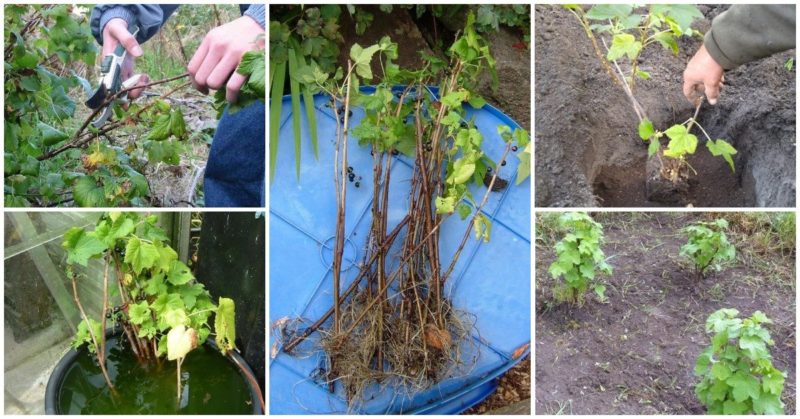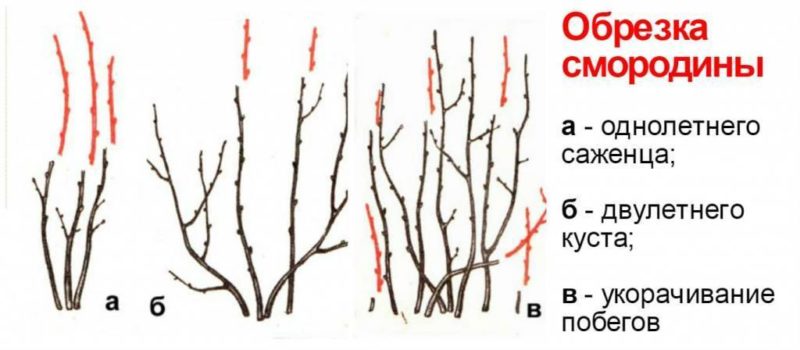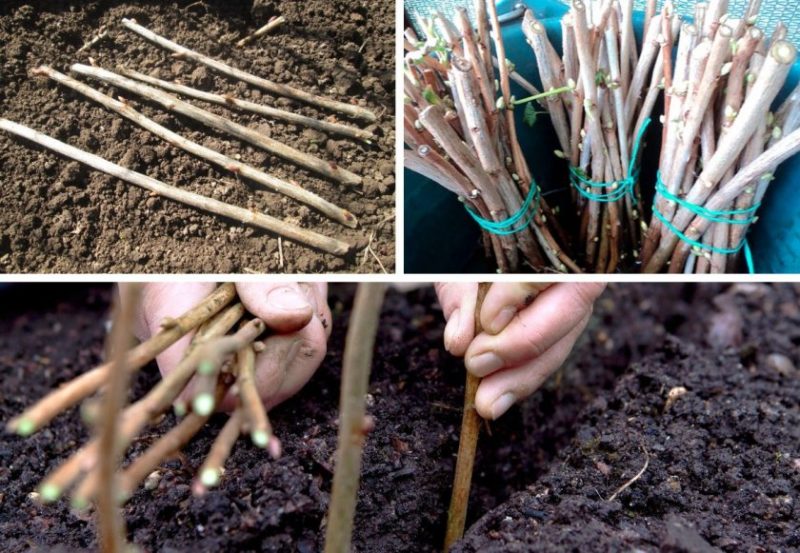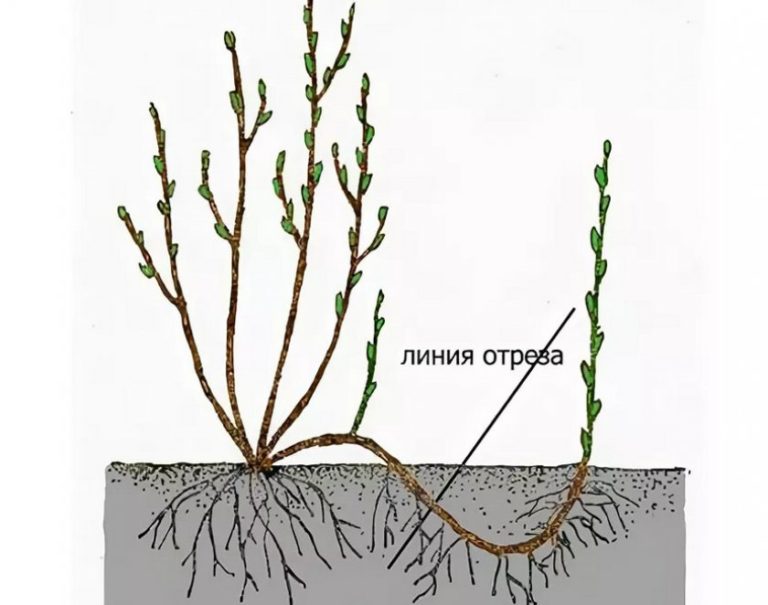Proper planting and further care of red currants for a bountiful harvest
Red currant is a moisture-loving crop that prefers areas near streams and rivers. In the garden, the best neighbors will be potatoes, peppers, tomatoes, onions, honeysuckle and gooseberries. Experienced gardeners recommend planting the shrub in early September so that it has time to take root in its new location. Read more about planting and caring for red currants in our article.
Basic rules for planting red currants

Red currant is a deciduous shrub of the gooseberry family. In the wild, the crop grows in the forest zone, forms thickets on the edges, prefers damp areas - near rivers and streams.
Planting red currants requires following a number of rules:
- It is recommended to plant seedlings in early September. The main thing is not to miss the time when the buds go into the dormant period, otherwise the plant will not have time to take root and prepare for wintering.
- Red currants are planted in the fall in the regions of the middle zone. During the autumn-winter period, the earth has time to sink and become denser.
- In areas with little snow in the winter, freezing of the roots is possible, so seedlings are planted in the spring and dug in for the winter.
- If autumn planting was not possible, this can be done at the end of April. However, seedlings planted in autumn often outstrip plants planted in spring.
- The planting pattern depends on the variety: compact bushes with straight branches are planted every 1-1.25 m, spreading bushes with a lush crown - every 1.5 m.
- Most modern varieties of red currant are self-fertile, and therefore do not require the proximity of pollinating varieties.
- Red currants love sunny areas located in lowlands. However, the crop should not be planted near swamps, especially if sedge grows on them.
- The shrub grows and bears fruit best on loam and sandy soil. But at the same time, the soil should be as fertile as possible, fertilized with organic matter.
- Red currants do not like an acidic environment - at a pH of 5.5 and above, yields decrease and the risk of viral and bacterial infections increases.
- Slightly acidic or neutral chernozems and soils with a high humus content are suitable for shrubs.
The best predecessors and neighbors of the crop are honeysuckle, gooseberries, potatoes, onions, peppers, tomatoes and other vegetables, except horseradish. Unfavorable neighbors - cherry, walnut, apricot, raspberry, plum, blackberry, black currant.
Soil preparation
2-3 weeks before planting, it is necessary to prepare the soil and site: plow the ground, loosen and remove plant debris, dig a hole measuring 40x60 cm, mix the turf with 10 kg of humus or peat, 200 g of superphosphate, 30 g of potassium sulfate or ash.
Selection and preparation of planting material
It is recommended to purchase seedlings from specialized nurseries. They must have a developed, healthy root system, smooth bark without cracks, damage or signs of disease. You can also use layering, lignified or green cuttings for planting.
How to plant red currants correctly: step-by-step instructions
Algorithm for autumn planting red currants:
- Immerse the seedling in a bucket of water for 2-3 hours immediately before planting.
- Place the bush in the prepared planting hole, carefully straighten the roots and cover with nutritious soil mixture.
- Deepen the root collar by 5-6 cm. This promotes better growth of shoots and their regeneration from the buds, which are located in the area of the root collar.
- Make sure that there are no air bubbles under the roots. Shake the seedling when filling the hole with soil.
- Form a hill around the bush, water it generously with settled water and cover the tree trunk circle with peat or humus.
- Trim the branches so that 15-20 cm of length remain. Each of them should have 3-4 buds.
- After planting, water the currants every 3 days.
Perform spring planting in the second ten days of April, adhering to the autumn algorithm, with one exception: prepare the holes for bushes and soil mixture in the fall, and add only organic matter to the soil. Apply potassium-phosphorus supplements immediately before spring planting.
Reference. The bushes can be planted straight or at a 45° angle for better root formation.

Care after planting at different times of the year
Caring for red currants involves abundant watering, fertilizing, loosening the tree trunk and pruning. For spreading bushes it is necessary to make supports.
Watering
Red currants are watered abundantly, but not too often, during the period of growth of young shoots, flowering, formation of fruit ovaries and after harvesting. The crop needs moisture in the heat. To maintain optimal moisture levels, do not forget to mulch the tree trunk circle. This procedure will save you from the need to weed and loosen the soil around the bushes.
The periphery of the trunk circle must be carefully dug up from time to time so as not to damage the roots, which are not located too deep.
Top dressing
Throughout the growing season, currants actively consume nutrients from the soil, the reserves of which must be periodically replenished in order to reap a good harvest each year.
In the spring, add to the soil a mixture of 20 g of superphosphate, 5 kg of compost, 25 g of potassium sulfate for every 1 square meter. m. In early spring, add 40-50 g of nitrogen, 15 g of urea or 25 g per 1 sq. m. m.
After flowering, feed the plants with 10 liters of liquid mullein or chicken manure. In the fall, add 100 g of superphosphate and 30 g of potassium chloride and mulch the soil with peat and rotted manure.
Trimming

Pruning red currants is somewhat different from cutting the black variety. Fruit buds of red currants form at the base of last year's shoots, as well as on ringlets - small shoots on old branches 2-4 cm long. Therefore, berries appear on both young and old branches. It is recommended to perform anti-aging pruning of red currants much less frequently than pruning black currants.
The formed bush consists of 15-20 branches of different ages. To do this, after planting, the seedling is cut annually so that 2-3 young shoots remain on it, growing in different directions. The remaining branches are cut off.
Red currant shoots produce a harvest for 6-8 years, then they are replaced. Broken, dry, old and unproductive branches are removed from adult bushes. Shoots growing from the base of the bush are cut off for the purpose of thinning.
Annual shoots are not touched, since fruit buds are located at the tops. Pruning is carried out during the plant's dormant period - late autumn or early spring.In summer, the tops of young shoots are pinched to stimulate the formation of replacement shoots.
Wintering
Red currants withstand frosts down to -45°C, so they do not need special shelter. At the same time, strong winds and sharp temperature fluctuations can lead to freezing of perennial branches. Cover the bushes with spunbond, burlap, or simply throw snow on them to get out of the winter without loss.
Protection and prevention of diseases and pests
Red currants are susceptible to the same diseases as gooseberries: anthracnose, white spot, powdery mildew, terry, striped mosaic, rust, gray rot.
To combat fungal diseases, Bordeaux mixture, Kaptan, Homitsin, Fthalan, Topsin M, Fundazol, colloidal sulfur, and Kuprozan are used.
Viral diseases (terry disease and mosaic) cannot be cured, so experienced gardeners recommend carrying out preventive work on the site: loosening the tree trunk, removing weeds, mulching the soil with peat, promptly removing the affected parts and burning them.
Red currants are often attacked by the following pests:
- sawfly;
- currant gall midge;
- glassware;
- kidney and spider mites;
- leaf gall and gooseberry shoot aphids;
- gooseberry moth;
- moth;
- biennial leaf roller.

In the fight against insects, the following insecticides have proven themselves to be the best: “Cidial”, “Aktellik”, “Karbofos”, “Metafos”, “Rovikurt”, “Aktara”, “Phosfamide”, “Vofatoks”, “Tedion”, “Etafos Ambush” ", "Zolon", "Antio".
Propagation of red currants
In spring, red currants are propagated by woody shoots, in late summer and early autumn - by green cuttings and layering.
Lignified cuttings

In red currants, cuttings from the top of the branch take root better. Using a garden knife, make an oblique lower cut 2 cm below the bud. The top one should be straight, 1 cm above the top bud.
Next, the cuttings are planted in pots with a substrate or on a seedling bed. Separate containers later allow you to plant the material anywhere; in addition, the roots are less damaged during transplantation.
The soil for rooting lignified cuttings should be loose and well-permeable to moisture and air. The material is buried in the ground at an angle of 45°. One bud is left above the ground.
The cuttings are watered with clean water at room temperature if they were planted in a seedling bed. Cuttings in containers are buried in a convenient place in the garden. Before the onset of cold weather, constantly monitor soil moisture.
The method of propagation by lignified cuttings is used in spring or autumn. Although many gardeners prefer to carry out work at the beginning of the season, combining the cultivation of red currants with pruning after wintering. From one one-year-old stem, 3-5 cuttings are obtained, 15-20 cm long and about 7 mm thick.
More experienced gardeners germinate cuttings in winter, harvesting them in late autumn. During 3-4 months of winter, the cuttings take root in conditions close to summer. In spring, an almost mature plant is planted in the ground, which successfully adapts to return frosts and easily tolerates replanting.
Green cuttings
The method of propagation by green cuttings is used if it was not possible to propagate red currants using lignified cuttings. The workpiece is cut in the morning in cool weather. The optimal length of the cuttings is 12-15 cm. Each one should have 4-5 leaves. The top is cut at a distance of 5 mm from the bud, and the bottom is cut at an angle of 45°, 10 mm from the bud.
Before planting, the lower leaves are cut in half, and the cuttings are kept for 24 hours in a growth stimulator, then deepened into the nutrient substrate by 3-5 cm. The soil is prepared from peat, compost and sand 1:1:1. Green cuttings are planted in a greenhouse or open ground, but must be covered with polyethylene or hidden under glass jars. In conditions of high humidity, rooting occurs faster.
Green cuttings are protected from the sun with dark screens to prevent sunburn and watered generously for 20 days. After this, the number of waterings is reduced and the cuttings are fed with nitrogen fertilizers. After 10 days, the shelter begins to be periodically removed, increasing the time spent in the open air. Next, the plants are transferred to the cuttings, where they reach the desired state within a year, after which they are transplanted to a permanent place.
By layering

Propagation by layering is the easiest way to get several young and strong bushes. In the spring, the mother plant is inspected, the strongest and longest cuttings are selected and added in drops.
To do this, holes up to 15 cm are dug under the currants, into which the cuttings are placed. Compost, manure, turf or peat are placed at the bottom in a 1:1:1 ratio. Branches aged 2-3 years are used as layering, fixed in grooves and covered with nutrient substrate. Clean soil is poured on top and compacted.
By autumn, the cuttings will take root, after which they can be separated from the mother bush. One layer produces 3-5 bushes. In the fall they are transplanted to a new place. The cuttings take root within 2 years and begin bearing fruit in the 3rd year.
Dividing the bush
Gardeners rarely practice propagation by dividing a bush because they consider this method ineffective.Its essence lies in dividing the bush into parts that are completely ready for planting. The method is used at the end of the growing season.
First, choose a site for planting, dig a hole 60-70 cm deep, fill it with a mixture of humus, ash, turf and plenty of watered clean water. The bush is carefully dug up, trying not to damage the root system, annual shoots are left on it and shortened to 25 cm. Old branches are removed with pruning shears. The bush is divided into 2-3 parts, making sure that strong roots and shoots remain in each of them. The plant is planted in a permanent place, watered and hilled.
Features of care for different varieties of red currants
There are many varieties of red currants. Each of them has distinctive features, but in many ways they are similar. The culture is characterized by winter hardiness, drought resistance, and high yield.
The care rules are the same for everyone, but may vary depending on the characteristics of the variety. For example, the Viksne variety is resistant to most diseases and pests. The Ural beauty is not damaged by sawflies and moths, and is resistant to powdery mildew. Fertodi is immune to fungi and bears large berries. The Rondom variety is characterized by compact bushes and resistance to anthracnose and severe frosts.
Sweet variety Red Cross affected by anthracnose. Early sweet is demanding in terms of care and soil composition.
Early variety Firstborn frost-resistant, high-yielding and resistant to mycoses. Serpentine is immune to diseases and pests. The Shchedraya variety is resistant to anthracnose and bud mites.
Mid-season variety Rose resistant to most diseases, bears large berries with a delicate sweet taste. The Buzhanskaya and Gazelle varieties are immune to mycoses.
Late varieties Valentinovka, Marmaladnitsa, Osipovskaya, Dutch red They are distinguished by their endurance, ease of care and winter hardiness.
For the Moscow region, the Urals, Siberia winter-hardy varieties are suitable Asya, Natalie, Jonker van Tets, Rachnovskaya, Nadezhda.
Advice. Choose a variety for planting that best suits the climatic conditions in the region, as well as your needs. If you don’t want or can’t spend a lot of time on the plot, plant the most unpretentious, high-yielding varieties.
Advice from experienced gardeners
Advice from experienced gardeners will help you successfully grow redcurrants on your plot:
- Choose well-lit areas in the middle of the garden for planting.
- Maintain a distance between bushes of 1.25-1.5 m, depending on the spreading nature of the crown.
- Plant the plants next to fruit trees with a sparse crown to provide protection from the scorching sun.
- Prepare the soil in advance: apply organic or mineral fertilizers six months before planting the bush in a new location.
- Plant currants at an angle so that the roots can better absorb moisture. Over time, the bush will straighten out.
- Red currants love abundant watering and grow better with high soil moisture. Plant shrubs in low-lying areas with standing water or near streams or rivers.
- In spring, water the plants abundantly - 3-4 times a day for 2-3 weeks, in autumn - 1-2 weeks before frost.
- During the period of active growth and formation of ovaries and berries, currants need increased watering. Water consumption per 1 sq. m - 20-30 l. Impregnation depth - 30-40 cm.
- Red currants do not tolerate chlorine, so fertilize with this feature in mind.
Conclusion
Caring for red currants in open ground is not burdensome, but requires compliance with a number of rules. The plant needs abundant but not too frequent watering, loosening of the tree trunk, mulching with peat or humus, formative and rejuvenating pruning, prevention of viral and bacterial diseases, application of organic and mineral fertilizers to maintain health, active fruiting and preserve taste.